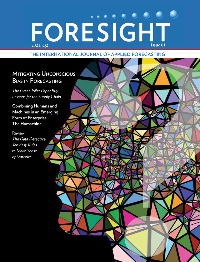 Following is Editor Len Tashman's preview of the new issue of Foresight: The International Journal of Applied Forecasting. Jonathon Karelse, author of the lead story, will be presenting in the Practitioner Track of the International Symposium on Forecasting (June 27-30).
Following is Editor Len Tashman's preview of the new issue of Foresight: The International Journal of Applied Forecasting. Jonathon Karelse, author of the lead story, will be presenting in the Practitioner Track of the International Symposium on Forecasting (June 27-30).
Preview of Foresight #61 (2021:Q2)
For many years, we’ve identified Foresight issues by the seasons of publication as those of us who live in the Northern Hemisphere experience them. A continuation of this policy would see the current issue labeled Spring 2021. But Foresight is distributed to IIF members across the globe, including many located in the Southern Hemisphere: South America, Australia and New Zealand, and the African continent. There, spring is autumn, winter is summer—and so, with all due respect, the editorial board has decided to redesignate the journal’s publication by calendar-year quarter. Hence, this issue of Foresight, number 61, is being published as 2021:Q2, and future citations will reflect this new issue identification.
And now, on to the contents of issue 2021:Q2 of Foresight.
In our feature article, Mitigating Unconscious Bias in Forecasting, Jonathon Karelse—cofounder and CEO of NorthFind Partners, a global management consultancy—presents the results to date of his team’s study of the prevalence of unconscious biases and heuristics in the forecasting/demand-planning process. They found that the presence of unconscious biases of various types is nearly universal and appears even more pronounced in forecasters/planners than others playing a part in the system.
Unconscious biases are present throughout the forecasting process, including the choice of data sources, algorithms, judgmental adjustments, and manners of reaching consensus. Many organizations fail to recognize the importance of strict guidelines for forecast adjustments, and their absence allows biases to negatively impact forecasts.
Commentaries on Jonathon’s article are provided by Paul Goodwin, author/editor of Foresight’s Hot New Research column, and Jeff Baker, whose analysis of the forecast value added concept was featured in our prior issue of this year.
In our section on Supply-Chain Forecasting, Tonya Boone and Ram Ganeshan examine The Great Toilet Paper Buy: Lessons for the Supply Chain, explaining how crisis-driven demand reshaped the manufacture and distribution of this essential product, with the result of altering and very possibly improving its supply chain.
The Humachine, a new book by Nada Sanders and John Wood, presents a strong case for the argument that AI itself will not provide the “superintelligence” that firms seek to enhance performance. Rather it is in the synthesis of human and machine—the humachine—that organizations will reap benefits that extend well beyond those achievable by humans or machines alone. In their distillation of the work for Foresight—Combining Humans and Machines in an Emerging Form of Enterprise: The Humachine—they report that some leading firms are already exhibiting traits of the humachine and describe how this new enterprise form will fundamentally alter organizational functions, with few of these impacted as much as the forecasting function.
Their discussion is embellished by three Commentaries. Niels van Hove probes into precisely how AI will enhance productivity and competitiveness and concludes that it is by automating the knowledge worker. Niels writes that “we are entering an era where we change from people doing the work supported by machines to machines doing the work guided by people.”
David Orrell observes that while humans certainly have their limitations as decision makers, AI and ML algorithms excel at some things but do far less well at others:
In health care, for example, where data analytics is playing an increasingly important role, ML algorithms can be frustrated by the noisy nature of the data, to the point where there are few rigorous studies that demonstrate superiority over expert-based methods.
So the problem, he stresses, is how to fuse humans and machines to work together in synergy, and he illustrates progress being made here in fields from customer-relations management to geopolitics.
Ken Fordyce concludes the discussion by presenting a historical perspective on the challenge of creating a humachine. How to best support decision making with technology, he writes, has been an ongoing challenge for many decades, producing both successes and failures. He recommends, among other things, that successful integration of technology into organizational processes is “best addressed by small, advanced analytics teams, which know how to nudge an organization from its current comfort zone to its next (more advanced) comfort zone—that is, to function as agents of change.”
This issue closes with a review by Ira Sohn of Tim Harford’s new book, The Data Detective: Ten Easy Rules to Make Sense of Statistics. Harford, Ira notes, seeks to illuminate the disinformation, obfuscation, bad research, and misplaced motivation that undermine statistical reporting and offers a useful set of rules to overcome these impurities in the presentation and interpretation of data.
STRATEGIC PLANNING
It has been 17 years since the International Institute of Forecasters commissioned the development of a new journal that would make forecasting research and know-how accessible to the practicing forecaster. Foresight became a reality in the summer of 2005 and, as Editor for this era, I have tried to blend takeaways from scholarly research with the lessons gleaned from the experience and ingenuity of organizational practitioners. The journal’s content has been broadened by the dramatic increase in new methodologies, systems, and processes. It’s a vastly different and often bewildering new world in which the forecasting mission must be executed.
To gain better insight for the future evolution of the journal, I have commissioned a team of colleagues from the academic, consulting, and industrial spheres to examine issues that will set directions for Foresight’s future. These include:

• Orientation between practitioner and academic
• Channels for new content information and feedback
• Competition with other media
• Organization of conferences
• Mission of the Foresight Advisory Board
• Revenue enhancements
In these efforts, we welcome your thoughts as Foresight readers and members of the IIF.
